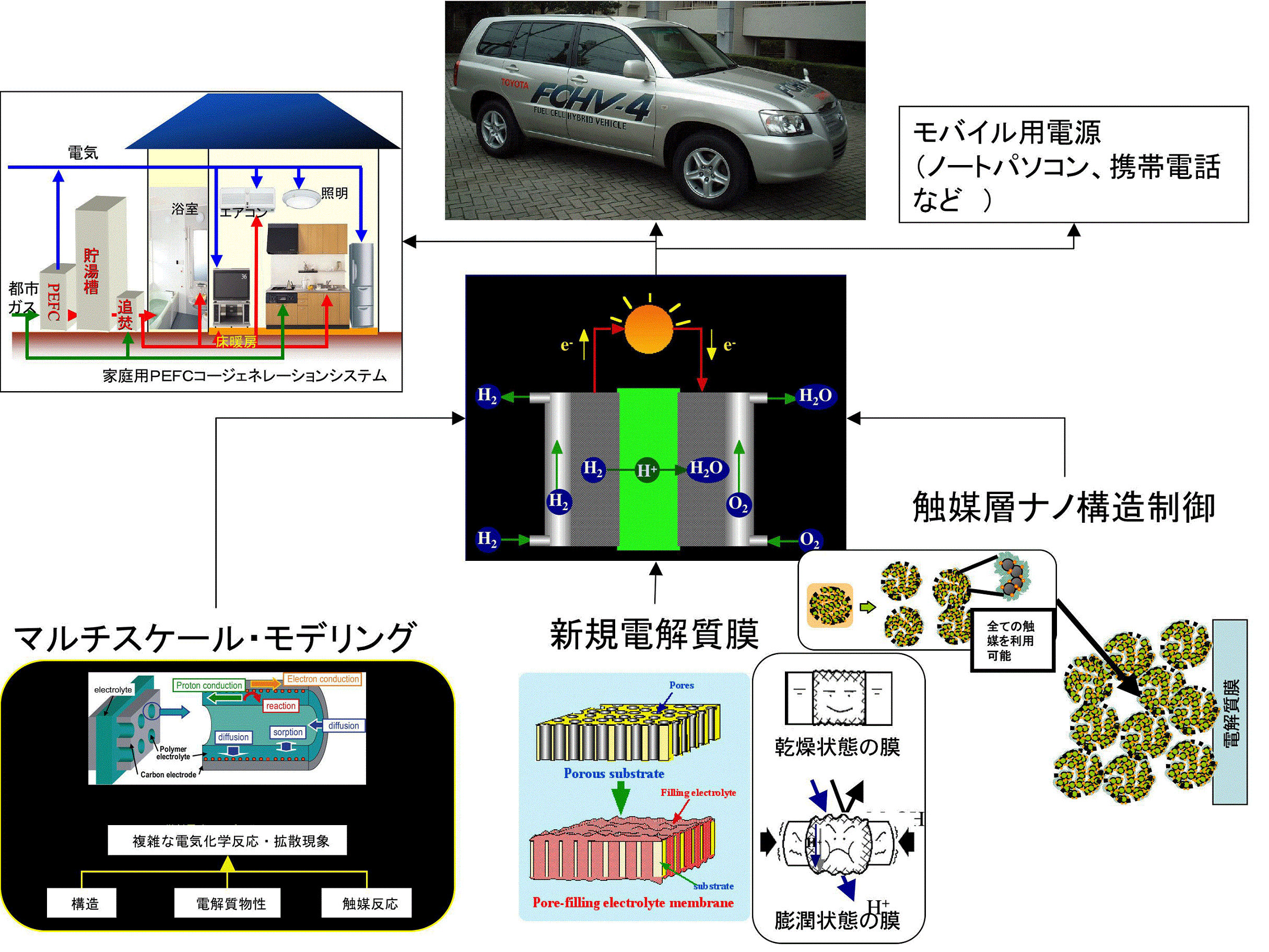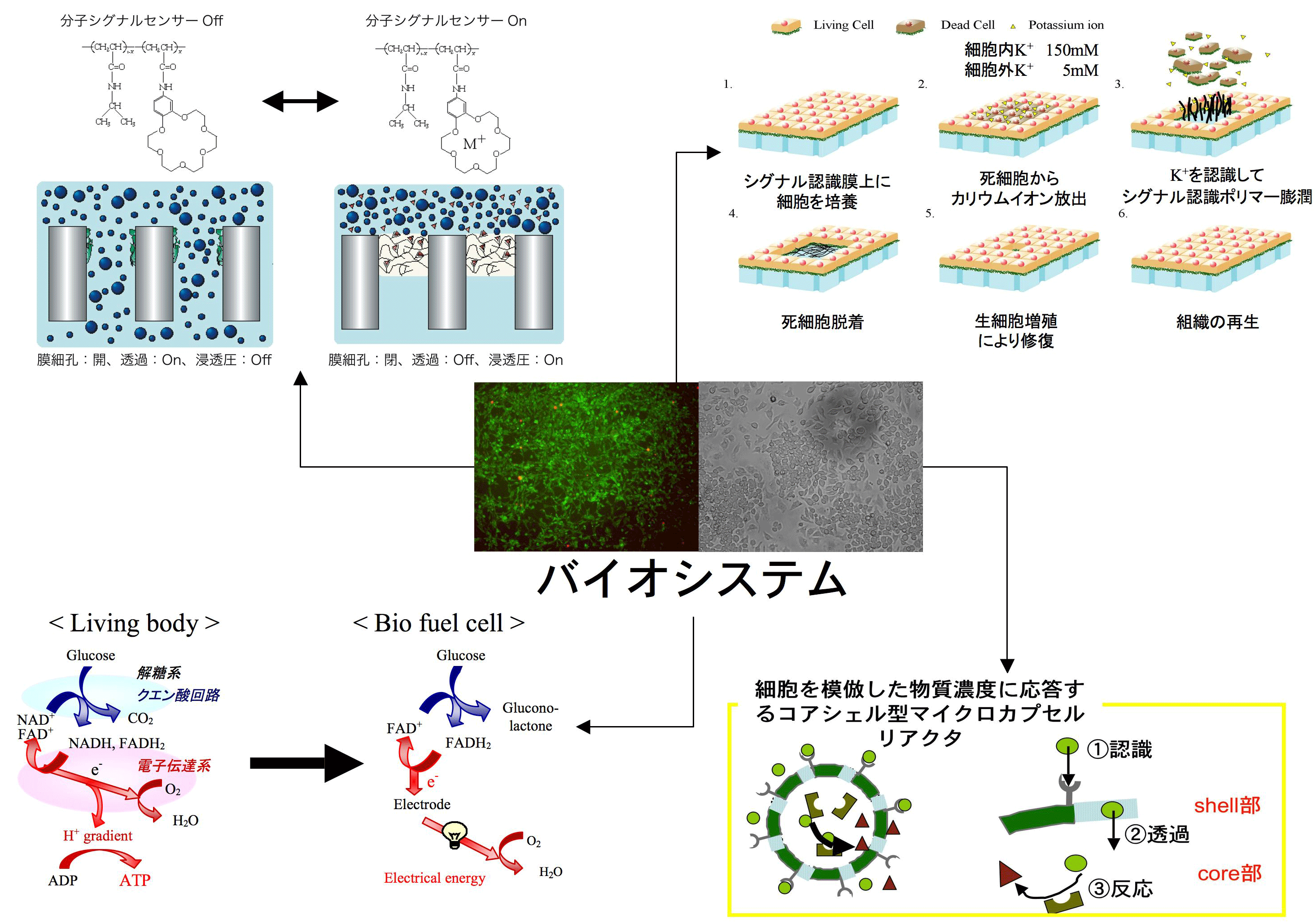Research
Research Philosophy
Novel functional materials are required to solve various problems such as global environmental problems, energy and resources problems, development of medical technology, and so on. However, simple bulk material has reached its limit to be used for solving these problems.
Traditional material development is based on try and error approach. In addition, many kinds of interesting and functional materials have already been synthesized and reported. For instance, although over twenty thousands of supramolecules have already been synthesized; only several dozen of those supramolecules are applicable for research and industrial purpose. This is due to lack of vision in developing new materials. Therefore, our group proposes a new methodology called “systematic material design”.
In the systematic material design concept, we are interpreting materials as a system. In this system, several element materials are bounded systematically, and evolve to a novel functional material. Actually, most of these functional materials, which have been already applied in the market, are composite material of several element materials. Nevertheless, most of these were materials were found accidentally. Thus, we aim to design a novel functional material systematically by combining several element materials on the basis of each physicochemical properties without depending on fortune.
For the systematic material design concept, these following points are important:
- system design within a material
- optimization of the designed system using modeling and computer simulation
- preparation of the designed material system using morphology control techniques in each hierarchy such as micro, nano, meso, and macro hierarchy.
Based on the systematic material design concept, we are developing both novel materials for energy process such as fuel cell and molecular signal stimuli-responsive materials inspired by biosystem. We consider that this approach is suitable for other various material developments.
Subjects of Research
Systematic design and development of energy materials and systemsPolymer electrolyte fuel cells (PEFCs) are key energy devices for emission-free clean hydrogen society, and utilized in the development of pollution-free vehicles and stationary energy devices. In order to facilitate widespread commercialization of the PEFCs, reducing or replacing the expensive platinum content of the catalyst and development of the materials available for wide range of operating conditions are required. The development of a modified version of the PEFCs, i.e., Solid alkaline fuel cells (SAFCs) are also of great importance because of its advantages over PEFCs, which include the use of no platinum catalyst, use of liquid fuel as a hydrogen source, in addition to its high energy density compared to its counterpart. However, the material development of SAFCs is still in early stages, and many efforts are being taken to develop novel durable anion conducting membranes and low cost, no platinum-based highly active catalysts in alkaline medium, and hence is the key factor of this technology.
We are actively involved in systematic design and development in new materials from the molecular level to the device level. In the fuel cell systems, different components such as membrane, catalysts, and catalyst layer share significant functions and work in a well-coordinated manner, and hence, the total cell system must be optimized for the best performance. Here we investigate the proper tailoring of materials by systematic design and fabrication of concerned cells for PEFCs and SAFCs.
In membrane development, our speciality is the development of "pore filling membranes", which are fabricated by filling polymer electrolyte into the pores of the stable porous substrate. This type of fabricated membrane strongly suppresses the swelling of polymer electrolyte due to the usage of the mechanically strong porous substrate, and many problems during fuel cell operation such as low ion conductivity, fuel crossover, and dimensional stability are solved by the pore-filling membrane.
In catalyst development, we have successfully designed and made a carbon-free metal alloy porous capsules catalyst. The unique beaded metal network structure of this catalyst enables surprisingly high activity for the oxygen reduction reaction in PEFCs. Moreover, the elimination of carbon solves the problems of carbon corrosion and concentration overpotential during the fuel cell operation.
We are also focused on developing packed acid type electrolyte membranes, Pt-free carbon alloy catalysts and durable anion-exchange membranes based on the systematic design approaches. The technology of hydrogen production is also important for the hydrogen society, and water splitting materials are also being developed.
Biofuel cells, which use enzyme as catalyst, are another clean energy devices because of their ability to oxidize nontoxic fuels, such as glucose and ethanol. We are also developing materials for them to further increase in the current density.

Stimuli-responsive membranes inspired from Biosystems
Inspired by bio-membranes which can alter molecular permeation through membrane channels in response to environmental change and during course of time, we have developed ?molecular recognition gating membranes? that open and close their pores by specific molecular recognition. These types of membranes are fabricated by immobilization of sensor molecules and actuator polymers into the pores of membranes. Typical examples of such artificial gating membranes include host-guest complex of crown ether and ?-cyclodextrin as sensor molecules, which exhibit controllable gating function of membrane pores and autonomous oscillation of water permeation. These bio-inspired synthetic membranes show quick response within one minute with high sensitivity, since the volume change of the actuator polymers occurs inside of the small nano-sized pores, hence can find applications in bioanalytical systems, such as medical assays and biochips. Thus, we execute the design of protein-recognition gating membranes employing biotin or DNA that can rapidly detect a low concentration of disease marker proteins.

Sea water desalination and waste water treatment have been important processes to produce usable water resources and promote a sustainable society against the explosion of human population, especially, in Africa and Asia. Water filtration using polymeric membranes is an efficient and cost-friendly method to prepare clean water; however, suppression of fouling and protein adsorption of membrane pores is required and challenging theme. Technology of surface grafting in porous membrane is one of our expertise and strengths, especially, functionalizing only inside of membrane pores by exploiting plasma treatment that can control surface property, and we then develop anti-fouling membranes by pore surface modification by grafting of polymers, synthesized by controlled polymerization protocols, including ATRP and RAFT. In addition to this, we also actively engaged in feasibility studies of membrane technologies, such as a forward osmosis by process design modelling.